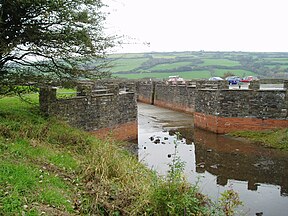Kidwelly and Llanelly Canal
The Kidwelly and Llanelly Canal was a canal and tramroad system in Carmarthenshire, Wales, built to carry anthracite coal to the coast for onward transportation by coastal ships. It began life as Kymer's Canal in 1766, which linked pits at Pwll y Llygod to a dock near Kidwelly. Access to the dock gradually became more difficult as the estuary silted up, and an extension to Llanelli was authorised in 1812. Progress was slow, and the new canal was linked to a harbour at Pembury built by Thomas Gaunt in the 1820s, until the company's own harbour at Burry Port was completed in 1832. Tramways served a number of collieries to the east of Burry Port.
In 1832 engineer James Green advised on extending the system, and suggested a line with three inclined planes to reach Cwmmawr, further up the Gwendraeth Valley. Although Green had experience with inclined planes on other canals, he underestimated the cost and could not complete the work. He was sacked in 1836, but the canal company finished the new route the following year. The canal was moderately successful, and shareholders received dividends from 1858. In 1865 the company changed its name to become the Kidwelly and Burry Port Railway, amalgamated with the company running Burry Port in the following year, and the canal became the Burry Port and Gwendraeth Valley Railway in 1869.
Kymer's dock at Kidwelly continued to be used for the export of coal by coasters for another 50 years. It was used as a rubbish dump during the 1950s, but together with a short section of the canal was restored in the 1980s. A few of the structures of the canal can still be traced in the landscape, and the route of the now closed railway can be followed for most of its length.
The area around Kidwelly is rich in coal reserves and contains ironstone. It was to exploit these reserves that the canal and tramway system was built. Much of the coal was good quality anthracite, although other grades were also mined.
Thomas Kymer began mining at Pwll y Llygod and Great Forest (near Carway) in 1760, and sought parliamentary approval to construct a canal at his own expense in early 1766. The Act of Parliament was granted on 19 February 1766. The canal was to run from his coal pits at Pwll y Llygod on the banks of the Gwendraeth Fawr river to Ythyn Frenig, about half a mile (0.8 km) to the west of Kidwelly, where he built a dock on the southern bank of the Gwendraeth Fach river. The Act included powers to divert the course of the Gwendraeth Fawr from Pwll y Llygod to Pont Spwdwr, where the Kidwelly to Llanelli turnpike road crossed the river. The canal was operational by May 1768.
...
Wikipedia

